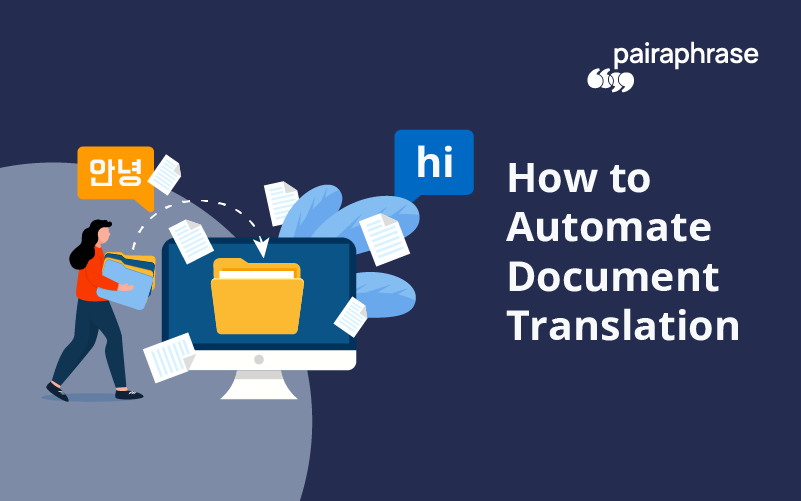For most enterprises, automated document translation is a necessary component of internal and external communication. There are simply too many files flowing through a multinational organization to not consider this. Especially because it will save the company time and resources when properly implemented.
When you learn how to automate document translation, you save time and streamline your multilingual document publishing workflow. You also carve out the opportunity to drastically improve the quality of your translations.
That being said, here are 10 steps for achieving automated document translation in your organization.
10 Steps for Automated Document Translation
1. Identify where the document translation process begins and ends
In order to automate document translation, you need to get clear on what the whole process looks like from start to finish. It’s crucial to identify the people in your organization who are involved at any step of the way. Learn what role they play and take notes.
Typically, any translation process truly begins with the source document publisher or originator. So this is a great place to start. Keep in mind there could be multiple publishers or originators in each department and several different departments to which this applies.
2. Identify the types of documents originated by each department
Because your translation process could look different depending on the type of document at hand for any given project, it’s helpful to determine the types of files typically need translation from each department. This information should include file format and file content. Record this information.
3. Define the audience of the final translation for each document type
Once you have a grasp on the types of source documents each department creates, it’s important to understand who is going to be consuming those specific documents once they are translated. For instance, if a Human Resource Manager develops an employee handbook, the audience would be the employees.
Include this information in your notes. This is important because the translation quality importance will differ by audience.
4. Determine the importance of translation quality for each document type
Not every document is created equally when it comes to translation quality. For example, you might not spend as much time polishing an internal communications document as you would for a customer product safety manual.
Create a “quality importance” scale and assign a number to each type of document. That number will denote how much time and translation accuracy truly is required by each document type. This will then help you create a protocol for how each type of translation will be produced.
5. Define protocol for each number
For each number on that scale, there should be an action assigned. For example, if it’s an automotive safety manual with complex technical information, you might assign it a 10. And the protocol for this high level of accuracy might mean that the originator uploads the document to your translation software and shares it directly with a specialized automotive translator, instead of only having someone run it through a machine translation engine without post-editing.
6. Identify bottlenecks
If automated document translation appeals to you, it’s likely that some parts of your current process either slow down translation development or cause extraneous work. This is why it’s important to get clear on any bottlenecks or obstacles that hold up any other steps in the translation process.
This will not only help you understand what tools you need later to fix those, but also what takes so many hours and why. You’ll need to interview the people involved in these processes and have them record their steps and take note of what takes so long and the reasons behind it.
7. Address the bottlenecks
Come up with solutions for the bottlenecks that are impediments to the automation of document translation. An efficient translation process is what’s going to save you time and money, and the bottlenecks are what is going to stop you from achieving efficiency.
8. Establish publishing standards
Since you’re bound to use machine translation in your automation, it’s important to establish publishing standards. This means creating and distributing a list of guidelines for your employees to follow when they create source documents.
It matters because there are ways to write for machine translation engines so that there is less to post-edit. And that will save more time during the translation process.
9. Adopt translation management software
Once you have completed the steps above, you will be able to make an informed decision on the translation management software that works best for your team. A translation management system can further automate your workflow with technologies such as Translation Memory and Machine Learning.
We suggest you schedule demos and free trials of a few web-based translation management systems. While ease of use and features vary among these online software platforms, overall they tend to support team collaboration and scalability better than desktop translation software.
10. Audit your automated translation process periodically
Once you have automated your translation process, you should audit it periodically. Over time, your company is bound to grow and experience changes. This means you might need to tweak your automated document translation process so that it’s updated for new organizational changes and needs.
Automate Document Translation in the Cloud
Pairaphrase will help you automate your document translation process. It helps you achieve faster, smarter and safer translations in 140+ languages (20,000+ language pairs) and 24 file formats.


.png)

.png)



